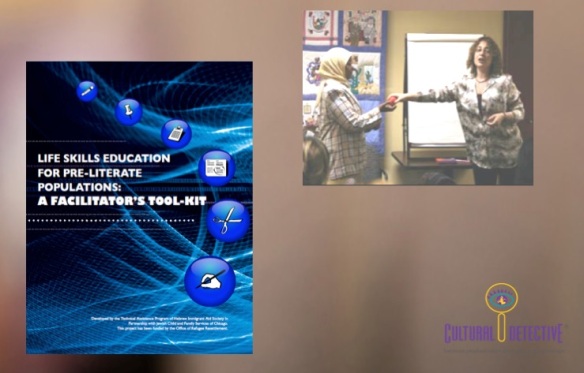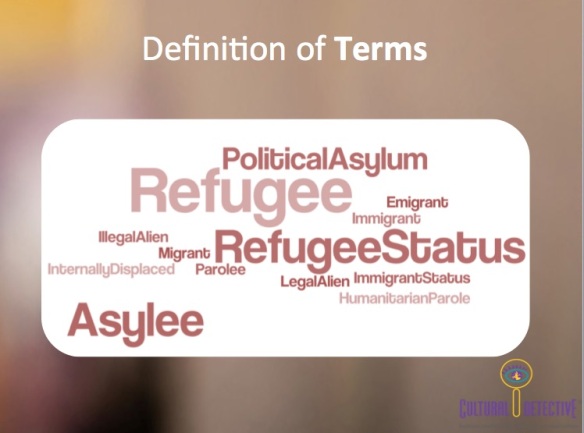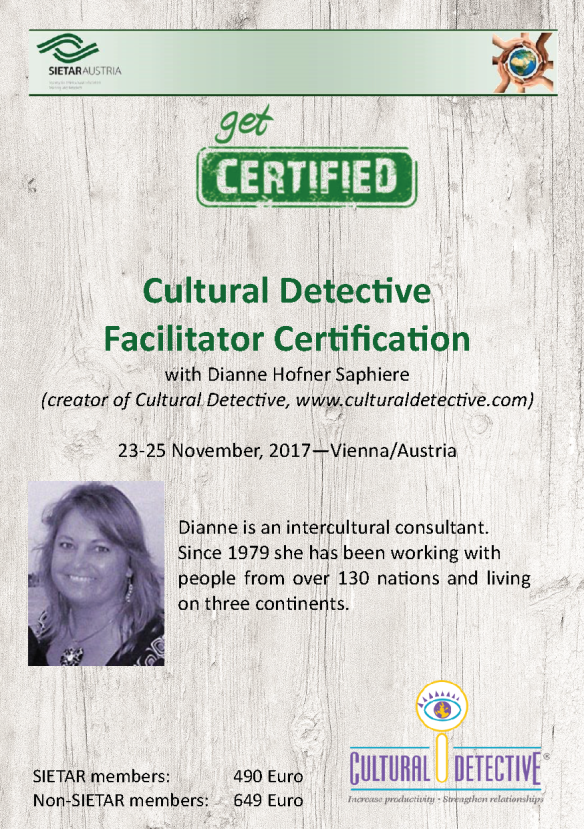 There are over 20 million refugees in our world, according to UNHCR. The AVERAGE length of time a refugee spends in a camp—in limbo, in transition, waiting—is 17 years; not months: YEARS!
There are over 20 million refugees in our world, according to UNHCR. The AVERAGE length of time a refugee spends in a camp—in limbo, in transition, waiting—is 17 years; not months: YEARS!
Cultural Detective conducted a complimentary webinar on strategies for helping refugees and their receiving communities. It was conducted by Tatyana Fertelmeyster, herself a refugee, who has worked in refugee resettlement for several decades.

The webinar was so well received that we did a second one, for a different time zone. Then, SIETAR Austria and SIETAR Europa asked us to do a third. The next step will probably be a dialogue among seasoned practitioners. Interculturalists have crucial talent and resources to contribute to this crisis, and Cultural Detective is a tool that provides a remarkable service to both refugees themselves and their receiving communities.
There are several powerful learnings that participants take away from the ninety minutes. One is how complicated and confusing the entire resettlement process is. For example, there are so many different terms, which technically mean so many different things. The key component underlying the refugee experience is fear, and legally, refugees are those who travel across national boundaries. Those who are forced to relocate out of fear yet remain in their own countries are internally displaced.
 Then there is the statelessness. Most refugees are forced to abandon their citizenship when they emigrate. Since, on average, they wait 17 years before finding a new home, that’s an awfully long time not to “belong” anywhere! Then there is the concept of time, of waiting, of living in limbo. If a child has been raised in a refugee camp, or an adult has lived in one for years, and now in a new home has to keep timely appointments and behave proactively, it’s a HUGE cultural shift we’re expecting. The countries that receive the most refugees are often not the countries in which the refugees will live long-term; they are transit countries. This means that the refugees go through waves of transition and re-acculturation.
Then there is the statelessness. Most refugees are forced to abandon their citizenship when they emigrate. Since, on average, they wait 17 years before finding a new home, that’s an awfully long time not to “belong” anywhere! Then there is the concept of time, of waiting, of living in limbo. If a child has been raised in a refugee camp, or an adult has lived in one for years, and now in a new home has to keep timely appointments and behave proactively, it’s a HUGE cultural shift we’re expecting. The countries that receive the most refugees are often not the countries in which the refugees will live long-term; they are transit countries. This means that the refugees go through waves of transition and re-acculturation.
There is the loss of everything that is familiar, everything the refugee knows and is comfortable with. They basically fall down Maslow’s hierarchy of needs, losing self-actualization, self-esteem, love and belonging, in the quest for survival and safety. In the new country refugees often need to learn a new language, a new culture and way of life, at a time when they are nursing the wounds of loss and at their lowest emotionally. Members of refugee families experience and respond to these intense emotions in a diversity of ways. Grandparents may not adjust to new ways; parents may be insulted by children who adopt new ways and seem disrespectful; children may resent or feel ashamed of parents who don’t understand or who have values different than those they’ve learned to adopt.
A second powerful take-away from the webinar is an empathy for the loss that refugees experience. Several participants reported tears and crying during one of the activities, saying they felt sad, lost, desperate, a fear of the unknown, anger, resistance, shock, feelings of depression. The refugee experience demands extremely high levels of resilience.
—
 ACTIVITY
ACTIVITY
So, what was this exercise?
Objective: To establish empathy for the refugee experience.
Instructions: On a piece of paper, draw two intersecting lines, one vertical and one horizontal, to form four quadrants. Yes, sort of like a Cultural Detective Worksheet.
- In the upper left quadrant, list the names of the people who are your direct relatives: a legal spouse if you have one, and any minor-aged children.
- In the upper right corner, list the names of those you love: adult children, parents, grandchildren, dear friends, cousins. List as many people as are dear to you.
- In the lower left, list two to five small, portable things that are of value to you. These should be things the size of a book or so, something that fits into a pocket or a suitcase. They can have monetary or sentimental value, such as jewelry or photos.
- Finally, in the lower right, list the things you love about your life now that are too large or too permanently installed to move with you. This might be your home, car, heirloom furniture; or maybe it’s your ancestral grave site, a favorite park or…
Take your time. When you are finished:
- Take a good look at that last quadrant, the lower right. Put a big “X” through everything listed there. You won’t be able to take it with you. Let that sink in.
- Next, look at the upper right. One by one, draw a line through each and every name on your list. Unless those people are able and lucky enough to travel with you, you may not ever be seeing them again. You’ll have to say goodbye to them. Take a moment. How does that feel?
Debrief: Share reactions and feelings, and apply to real life.
—
We realized that refugees are expected to be grateful for their new homes, which most of course are; but that at the same time they are mourning losses that are beyond normal mortal capacity. Tatyana shared with us her own experience. Even as a trained social worker, as a relocated refugee she experienced anger, resentment and jealousy of her host, the very person who was helping her, and to whom she was so very grateful. The emotions are complex, intense, illogical, and very real.
The world is so focused these days on what to do with refugees—who to accept, how to ensure safety and security—that we often do not focus on what to do after the refugees reach their new homes. All too often we hear the world “assimilate,” which interculturalists know is a far-from-optimal adaptation strategy. Assimilation happens because a society is not accepting of those who are different, yet a refugee very much wants to fit in and be accepted. In the process, refugees can be successful, but they lose themselves, their heritage, and the receiving society loses the benefit of the unique insights and experience the refugees bring.
What are other options? Tatyana walked us through John Berry’s Acculturation and Adjustment Strategies. Along the “x” or horizontal axis we have how accepting society is of those who are different. Along the “y” or vertical axis we have how open an individual refugee is to change.

From “Immigration, Acculturation and Adaptation,” in Applied Psychology: An International Review, 1997, 46.1, pp. 5-68.
The quadrant we of course want to avoid is Marginalization, which is where terrorism, both domestic and international, are born. This is where difference is not accepted by society, and the individual retreats internally, shutting down to and closing out from the outside world.
Separation is not an ideal adaptation strategy, either. While we may enjoy the good eats of a Chinatown or the salsa dancing of a Latino district of town, separation leads to segregation, pulling society apart and leaving its members vulnerable to discrimination.
We should of course aim for integration, which requires an openness on the part of society and on the part of the refugee or individual. Refugees learn, grow and change, as does society, transforming itself into a more innovative and inclusive community.
Tatyana used Cultural Detective Values Lenses to illustrate the worldview a refugee might start out with, the values required for successful adaptation, and what might be important to those of the receiving country. We can easily use the Cultural Detective Worksheet in Cultural Detective Online to analyze our interactions with refugees, or with those in our new home, and learn how to adjust in a more integrated, less marginalized, separate or assimilated manner.
If you like the activity here, I’d also urge you to look at Caritas France’s “On the Road with Migrants” game, which is now available in English and German as well.
Want to sign up for one of our webinars? You can find the full schedule here.
 ITAM, the Instituto Tecnológico Autónomo de México, is a prestigious university in Mexico City, alma mater of many national leaders in diverse areas of society. They recently dedicated several days to learning in-depth about the complexities of the migrant experience, and the intercultural competence required to integrate new residents in meaningful ways to transform our communities.
ITAM, the Instituto Tecnológico Autónomo de México, is a prestigious university in Mexico City, alma mater of many national leaders in diverse areas of society. They recently dedicated several days to learning in-depth about the complexities of the migrant experience, and the intercultural competence required to integrate new residents in meaningful ways to transform our communities.










 Seven success values and the immigrant women who cultivated them by Fiona Citkin, due to publish in December 2018 by a Simon & Schuster affiliate
Seven success values and the immigrant women who cultivated them by Fiona Citkin, due to publish in December 2018 by a Simon & Schuster affiliate

 There are over 20 million refugees in our world, according to UNHCR. The AVERAGE length of time a refugee spends in a camp—in limbo, in transition, waiting—is 17 years; not months: YEARS!
There are over 20 million refugees in our world, according to UNHCR. The AVERAGE length of time a refugee spends in a camp—in limbo, in transition, waiting—is 17 years; not months: YEARS!
 Then there is the statelessness. Most refugees are forced to abandon their citizenship when they emigrate. Since, on average, they wait 17 years before finding a new home, that’s an awfully long time not to “belong” anywhere! Then there is the concept of time, of waiting, of living in limbo. If a child has been raised in a refugee camp, or an adult has lived in one for years, and now in a new home has to keep timely appointments and behave proactively, it’s a HUGE cultural shift we’re expecting. The countries that receive the most refugees are often not the countries in which the refugees will live long-term; they are transit countries. This means that the refugees go through waves of transition and re-acculturation.
Then there is the statelessness. Most refugees are forced to abandon their citizenship when they emigrate. Since, on average, they wait 17 years before finding a new home, that’s an awfully long time not to “belong” anywhere! Then there is the concept of time, of waiting, of living in limbo. If a child has been raised in a refugee camp, or an adult has lived in one for years, and now in a new home has to keep timely appointments and behave proactively, it’s a HUGE cultural shift we’re expecting. The countries that receive the most refugees are often not the countries in which the refugees will live long-term; they are transit countries. This means that the refugees go through waves of transition and re-acculturation. ACTIVITY
ACTIVITY